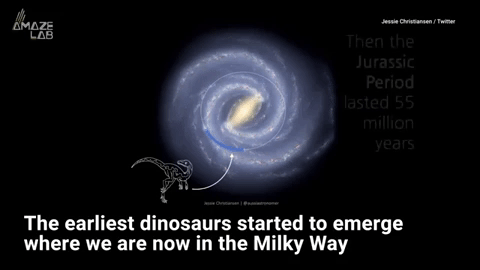WATCH: Dinosaurs traveled other parts of Milky Way than humans

Dr. Jessie Christiansen
- A new video shows how life has evolved on Earth during the planet’s most recent revolution around the Milky Way, also known as one galactic year.
- A galactic year is about 220 million years, and it was the beginning of the Jurassic period the last time Earth was at this point in its revolution.
- How will Earth look on its next galactic birthday? It’s impossible to know for sure, but a few events seem inevitable.
It’s been 200 million years since the dawn of the Jurassic period, the second of the three epochs in the Mesozoic era, during which dinosaurs roamed the Earth. But in terms of how many galactic years have passed since then, the count is just one.
Just as the Earth orbits the Sun, our solar system revolves around a supermassive black hole at the center of the Milky Way galaxy. To complete one revolution takes about 220 million years. So, if you were to look back to when Earth was at this exact point in its previous revolution, you wouldn’t see humans. Or any primates. Instead, you might see reptilian pterosaurs flying in the skies, plesiosaurs swimming in the oceans, and massive, razor-clawed theropods walking the land, among other ancient animals that no longer exist today.
To give perspective to the sheer magnitude of Earth’s galactic year, NASA research scientist Dr. Jessie Christiansen made a video mapping the evolution of life to Earth’s most recent revolution around the Milky Way.
Interestingly, the Jurassic period only took place on one side of the Milky Way, and when Earth was last on the opposite side of the galaxy, it was the mid-Cretaceous period. If you imagine progress of a galactic year as one hour on a clock, the time during which humans have existed on Earth would represent much less than one minute. And that’s just for the most recent galactic year.
To get a sense of the physical scale at which this process occurs, check out this video from the American Museum of Natural History.
The Milky Way in future galactic years
Christiansen ends her video by asking what Earth will be like on its next Galactic birthday. It’s difficult for scientists to know for sure, but a couple likely changes include: each day will be an hour longer, due to a slowing of the Earth’s rotation, and the continents will have merged, making our modern map of the world virtually unrecognizable.
On the cosmic scale, making predictions becomes even more difficult. But based on the available data, a few events seem inevitable:
- 12 galactic years: No life exists on Earth, and from a distance the planet will likely show no signs that it ever supported life.
- 15 galactic years: The conditions on Earth are similar to those on Venus.
- 22 galactic years: The Milky Way and Andromeda Galaxy begin to collide.
- 500 galactic years: The universe has expanded so much that all galaxies beyond the Local Group have disappeared beyond the cosmic light horizon.





